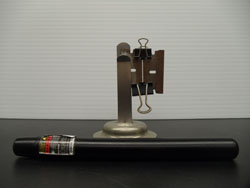![]()
Atomic Structure, Periodic Trends
8.4 Thin Slit Diffraction
 Subjects: Wave optics, diffraction, interference patterns
Subjects: Wave optics, diffraction, interference patterns
Description: A beam from a laser pointer is directed through a narrow slit onto the far wall of the lecture room. An interference pattern can be seen on the wall.
Materials:
- Two razor blades held closely together by metal clips
- Laser pointer (supplied by lecturer)
- Lab jacks (optional for positioning slit)*
*Located on the shelf above the central bench
Procedure:
- Set up the slit so that the pattern shows on a white wall.
- Dim the lights
- Turn on the laser pointer and direct the beam through the slit.
- Observe the interference pattern. The spacing of the ‘peaks’ can be related to the wavelength of light (~650 nm) and the distance to the wall.
Discussion:
This demonstration illustrates two properties of light – diffraction and interference. The instructor shines laser light from a laser pointer through a thin slit and an interference pattern is observed. When the light passes through the slit, it spreads out as it emerges from the slit – the narrower the aperture of the slit, the larger the angular spread. This phenomenon is called diffraction. Different parts of the wavefront at the aperture act as secondary sources of light and the diffraction pattern results from interference of waves from these sources.
The light areas of the pattern result from constructive interference that produces an amplification or increased intensity of the wave while the dark areas of the pattern result from destructive interference that lessens the intensity of the wave.
Safety:
None
References:
1. Physics4fun website: http://physics4fun.web.officelive.com/mmkhWaveoptics.aspx
2. B.Z. Shakhashiri. Chemical Demonstrations: A Handbook for Teachers of Chemistry. Vol 5; Wisconsin Press; 2011; p. 133


